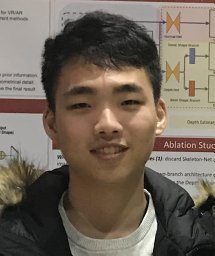
Feitong Tan
Research Areas
Authored Publications
Sort By
ChatDirector: Enhancing Video Conferencing with Space-Aware Scene Rendering and Speech-Driven Layout Transition
Brian Moreno Collins
Karthik Ramani
Proceedings of the 2024 CHI Conference on Human Factors in Computing Systems, ACM, pp. 16 (to appear)
Preview abstract
Remote video conferencing systems (RVCS) are widely adopted in personal and professional communication. However, they often lack the co-presence experience of in-person meetings. This is largely due to the absence of intuitive visual cues and clear spatial relationships among remote participants, which can lead to speech interruptions and loss of attention. This paper presents ChatDirector, a novel RVCS that overcomes these limitations by incorporating space-aware visual presence and speech-aware attention transition assistance. ChatDirector employs a real-time pipeline that converts participants' RGB video streams into 3D portrait avatars and renders them in a virtual 3D scene. We also contribute a decision tree algorithm that directs the avatar layouts and behaviors based on participants' speech states. We report on results from a user study (N=16) where we evaluated ChatDirector. The satisfactory algorithm performance and complimentary subject user feedback imply that ChatDirector significantly enhances communication efficacy and user engagement.
View details
Learning Personalized High Quality Volumetric Head Avatars from Monocular RGB Videos
Ziqian Bai
Danhang "Danny" Tang
Di Qiu
Abhimitra Meka
Mingsong Dou
Ping Tan
Thabo Beeler
2023 IEEE/CVF Conference on Computer Vision and Pattern Recognition (CVPR), IEEE
Preview abstract
We propose a method to learn a high-quality implicit 3D head avatar from a monocular RGB video captured in the wild. The learnt avatar is driven by a parametric face model to achieve user-controlled facial expressions and head poses. Our hybrid pipeline combines the geometry prior and dynamic tracking of a 3DMM with a neural radiance field to achieve fine-grained control and photorealism. To reduce over-smoothing and improve out-of-model expressions synthesis, we propose to predict local features anchored on the 3DMM geometry. These learnt features are driven by 3DMM deformation and interpolated in 3D space to yield the volumetric radiance at a designated query point. We further show that using a Convolutional Neural Network in the UV space is critical in incorporating spatial context and producing representative local features. Extensive experiments show that we are able to reconstruct high-quality avatars, with more accurate expression-dependent details, good generalization to out-of-training expressions, and quantitatively superior renderings compared to other state-of-the-art approaches.
View details
HumanGPS: Geodesic PreServing Feature for Dense Human Correspondence
Danhang "Danny" Tang
Mingsong Dou
Kaiwen Guo
Cem Keskin
Sofien Bouaziz
Ping Tan
Computer Vision and Pattern Recognition 2021 (2021), pp. 8
Preview abstract
In this paper, we address the problem of building dense correspondences between human images under arbitrary camera viewpoints and body poses. Prior art either assumes small motion between frames or relies on local descriptors, which cannot handle large motion or visually ambiguous body parts, e.g. left v.s. right hand. In contrast, we propose a deep learning framework that maps each pixel to a feature space, where the feature distances reflect the geodesic distances among pixels as if they were projected onto the surface of a 3D human scan. To this end, we introduce novel loss functions to push features apart according to their geodesic distances on the surface. Without any semantic annotation, the proposed embeddings automatically learn to differentiate visually similar parts and align different subjects into an unified feature space. Extensive experiments show that the learned embeddings can produce accurate correspondences between images with remarkable generalization capabilities on both intra and inter subjects.
View details
